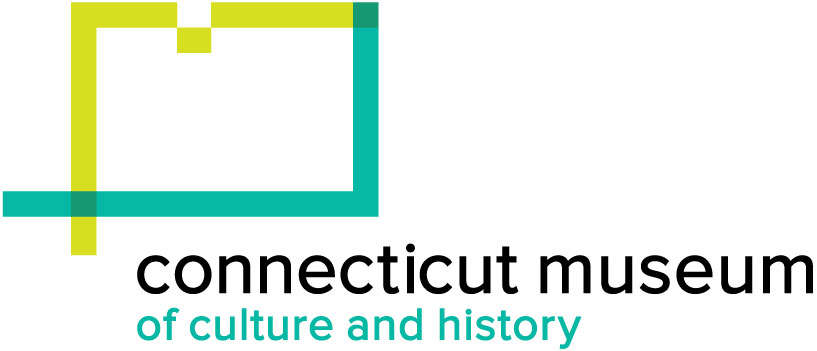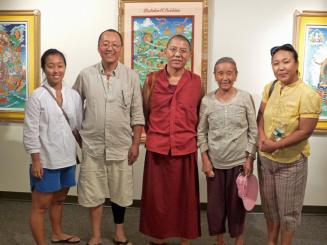Ambassadors of Folk Exhibit Gallery
Date2010-2011
Mediumborn digital video - MTS file
DimensionsDuration: 6 Minutes, 15 Seconds
ClassificationsGraphics
Credit LineConnecticut Cultural Heritage Arts Program collections
CopyrightIn Copyright
Object number2015.196.274.7
DescriptionVideo showing the gallery for the exhibition, "Ambassadors of Folk: Connecticut Master Traditional Artists." The works depicted were created by Val and Aili Galasyn, Romulo Chanduvi, Shengzhu Chen, and Aldona Saimininkas.
NotesSubject Note: "Ambassadors of Folk: Connecticut Master Traditional Artists" was an exhibit presented at the Institute for Community Research in Hartford, Connecticut, from June 10 through October 2010.Curated by the Connecticut Cultural Heritage Arts Program, the exhibit showcased the artistry of Connecticut folk and traditional artists who have achieved recognition on a national or international scale. The exhibit brought to wider attention the mastery of local artists who are highly respected exemplars of ethnic traditions within their communities. The eight visual artists and two performers featured represent a wide variety of artistic genres and ethnicities and share a high degree of technical skill and sophistication. The artists’ accomplishments represent entire lives spent serving their communities through cultural production.
Artists included Aldona Saimininkas, East Hartford; Romulo Chanduvi, East Hartford; Jampa Tsondue, Old Saybrook; Eldrid Arntzen, Watertown; Paul Luniw, Terryville; Valentine and Aili Galasyn, Canterbury; Shengzhu Chen Bernardin, Torrington; Marek Czarnecki, Meriden; performers Negrura Peruana, East Hartford and Daniel Boucher, Bristol.
Art forms exhibited drew from roots in Lithuania, Peru, Tibet, Norway, Ukraine, Finland, China, and Eastern Europe, but were all made and used here in Connecticut and beyond. One unifying characteristic is that these pieces have been created for use in a community’s traditional practices. For example, the Buddhist thangka paintings and the Byzantine Christian icons encourage active veneration, they serve a purpose beyond being paintings to be viewed. Other forms on display include decorative containers, cloth, commemorative pictures and rugs, wood carvings, and important seasonal decorations such as two types of dyed and etched Easter eggs. Performance traditions originate from African Peru and Québec. All of the art forms are beloved in the artists’ communities in Connecticut, where they serve as important expressions of cultural identity and heritage.
This exhibit celebrated the twenty years that the Connecticut Cultural Heritage Arts Program has worked with these and other remarkable traditional artists and their communities across the state.
Biographical Note: Val Galasyn has been a weaver of rug tapestries in the Finnish ryijy (pronounced ruya) style of woven and hand-knotted fabric used as warm bed covers and wall hangings in Finland. He has won awards from Finnish cultural organizations across the country, and was honored by Governor Rell with induction into the Connecticut Veterans Hall of Fame on the basis of his artistic work and long-time practice as a physician. Val weaves in collaboration with his wife Aili, a master of Finnish textile traditions. Aili has also received an award from the Secretary of the State for her decades of service to the town of Canterbury in eastern Connecticut where many Finns have settled.
Val and Aili augmented their knowledge of Finnish weaving techniques through a three-year apprenticeship with master weaver Seija Floderus under the Southern New England Traditional Arts Apprenticeship Program developed by the Institute for Community Research. Seija donated an old Scandinavian loom and taught several weavers at the Finnish American Heritage Society in Canterbury, Connecticut, an important cultural organization that promotes Finnish heritage. Val and Aili are life-long members, and donated the ryijy commemorating Finnish Independence from Russia in 1917. It hangs on the wall of the Finnish Hall auditorium.
Ryijy-weaving is a labor intensive process. First the loom is warped with linen thread. Then a base weave is added for several rows, alternating with three strands of wool that are individually hand tied and knotted onto the warp threads, very evenly and tightly to create the texture and heavy cover of the tapestry. A ryijy is usually large; historically they were woven with the date of a marriage and were used as a rug for the couple to kneel on during the marriage ceremony. Then the ryijy was hung on the wall as a family heirloom. The Finnish Independence Day tapestry is Val’s first ryijy and took him two years to make. Aili also weaves the linen towels that her family uses in their sauna.
Biographical Note: Romulo Chanduvi began learning the art of woodcarving and fine furniture-making from the age of twelve, growing up in Lima, Peru. He absorbed the techniques and styles of carving passed down in his family’s shop for generations, and served apprenticeships in private workshops in Argentina and Switzerland. Romulo began his career teaching furniture-making under the auspices of the AID Program of the United Nations, helping soldiers to acquire a trade after their military service. He continued to receive advanced training from master woodworkers, learning to work with tropical woods while practicing his artistic skills in Panama. Since 1993, when he received his green card as an “artist of exceptional merit,” Romulo has lived and worked in the Hartford area where he continues to create original woodcarvings as well as replicated museum-quality furniture for many organizations and private collectors. His Charles Street workshop walls are covered with carefully-arranged tools, vises, drills, and hundreds of chisels that Romulo has modified for use in hand-carving intricate details as well as to transform logs of exotic woods into extraordinary pieces of furniture. Each piece is built with authentic joining techniques of the appropriate period, and is finished with all-natural stains, resins, bee waxes, shellacs, and varnishes. His clients include several high-profile collectors in the northeast, and he recently created custom cases for the Sullivan Collection of 18th century porcelain at the Metropolitan Museum of Art. Romulo also creates traditional woodcarving in the Spanish/Inca style.
Romulo has been featured in several important exhibitions, including the Institute for Community Research touring exhibit "Living Legends: Connecticut Master Traditional Artists," and the Wadsworth Atheneum’s installation of "Faith and Fortune: Five Centuries of European Masterworks," and in a feature article in Home Living Connecticut magazine.
Romulo’s son Jonathan carries on the family tradition in restoration, establishing a successful studio in New York.
Biographical Note: Aldona Saimininkas creates Lithuanian pictures and traditional ornaments using straw, a traditional Lithuanian technique. In a time-honored process learned as a girl in Lithuania, she hand-picks rye straw from farm fields and prepares it to form ribbons which she then cuts into pieces, and irons it flat, glues it onto sheets of paper, then cuts shapes and forms which are compiled into geometric patterns or figurative pictures based on Lithuanian designs and scenes. These are assembled onto a dark background in abstract or floral folk art patterns that reflect Lithuanian weaving or embroidery, or to create a scene important in Lithuanian culture. Often these pictures are on a large scale, such as the Madonna commissioned from St. Andrew’s Church in New Britain, and altar pictures at Holy Trinity Lithuanian Church in Hartford. Aldona also makes hanging ornaments from pressed straw or straw tubes fashioned into stars, snowflakes, and birdcages for Christmas trees which glow like gold on the tree; painted Easter eggs; and straw mobiles called sodas (garden). Although a humble plant material, the golden color of the straw shines, signifying light. For over three decades Aldona has given workshops to Scout groups, Lithuanian gatherings and cultural schools, and adult classes throughout the U.S. and in Canada. Aldona’s work has been commissioned by St. Andrew’s Church in New Britain and the DeCordova Museum in Lincoln, Massachusetts, and one of her pieces was presented to Pope John Paul II. Her work was featured in ICR’s exhibit "Hidden Treasures: Connecticut Folk and Traditional Artists" at the Connecticut Commission on the Arts Gallery in March 2001, "Ambassadors of Folk" at the Institute for Community Research Gallery in 2010, and in "Connecticut Traditional Artists and Their Communities: An Exhibit Celebrating 25 years of the Connecticut Cultural Heritage Arts Program," at the Connecticut Office of the Arts Gallery in 2016. Aldona plays a central role in Connecticut’s Lithuanian community as an artist, tradition bearer, and cultural ambassador.
Biographical Note: Shengzu Chen Bernardin designs and dyes traditional Chinese resist-printed cloth (Jiao Hua) in a process that dates back to the Song Dynasty (960 – 1279). She learned the technique from her family at the age of seven, growing up in Jiangsu province in eastern China. Shengzhu first sketches a pattern in either a traditional design or one that she has created, then carves a stencil in that pattern onto oilpaper. The stencil is laid over cotton cloth and covered with a soy/lime/and water paste that goes through the holes and onto the fabric. After drying for seven days, the fabric is then dipped into natural indigo dye. The areas covered in soy paste remain white while the rest of the cloth takes the indigo dye and becomes blue. The shade of blue depends on how many times the cloth is dipped – at least three or four times for light blue and sometimes up to ten times for darker shades. In addition to lengths of cloth, Shengzhu also fashions clothing, decorative covers, wall hangings, and bags. She also works in a complicated three-stage Japanese tie-dyeing technique called Shibori. Shengzhu markets her work internationally as well as throughout the Northeast at festivals and quality craft shows, and she receives commissions for specialty designs from Chinatown businesses. Shengzhu is the co-author (with Lu Iui) of an extensive illustrated catalogue of traditional Chinese indigo dye patterns and processes, published in Chinese. She sells items through her website and gives information there about the process as well as Chinese legends about the origins of “China blue.”
Cataloging Note: This project was made possible in part by the Institute of Museum and Library Services MA-245929-OMS-20.
Status
Not on view


